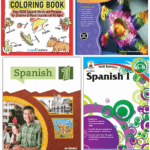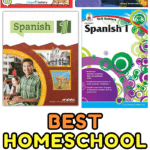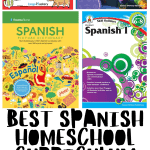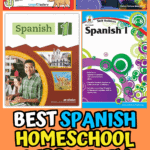Homeschool Spanish Curriculum We’ve Used (and Loved)
Finding a homeschool Spanish curriculum that actually works at home hasn’t been easy.
I’m not fluent in Spanish myself, so I needed something that would guide my son clearly without overwhelming either of us.
Over the years, we’ve tested workbooks, apps, live classes, and full foreign language curriculum, some stuck, others didn’t.
What we’ve learned is that the best programs mix structure with flexibility and make learning the language feel doable, even for beginners. Whether your child is in preschool or high school, there’s a Spanish resource out there that can fit your homeschool style and keep them motivated.
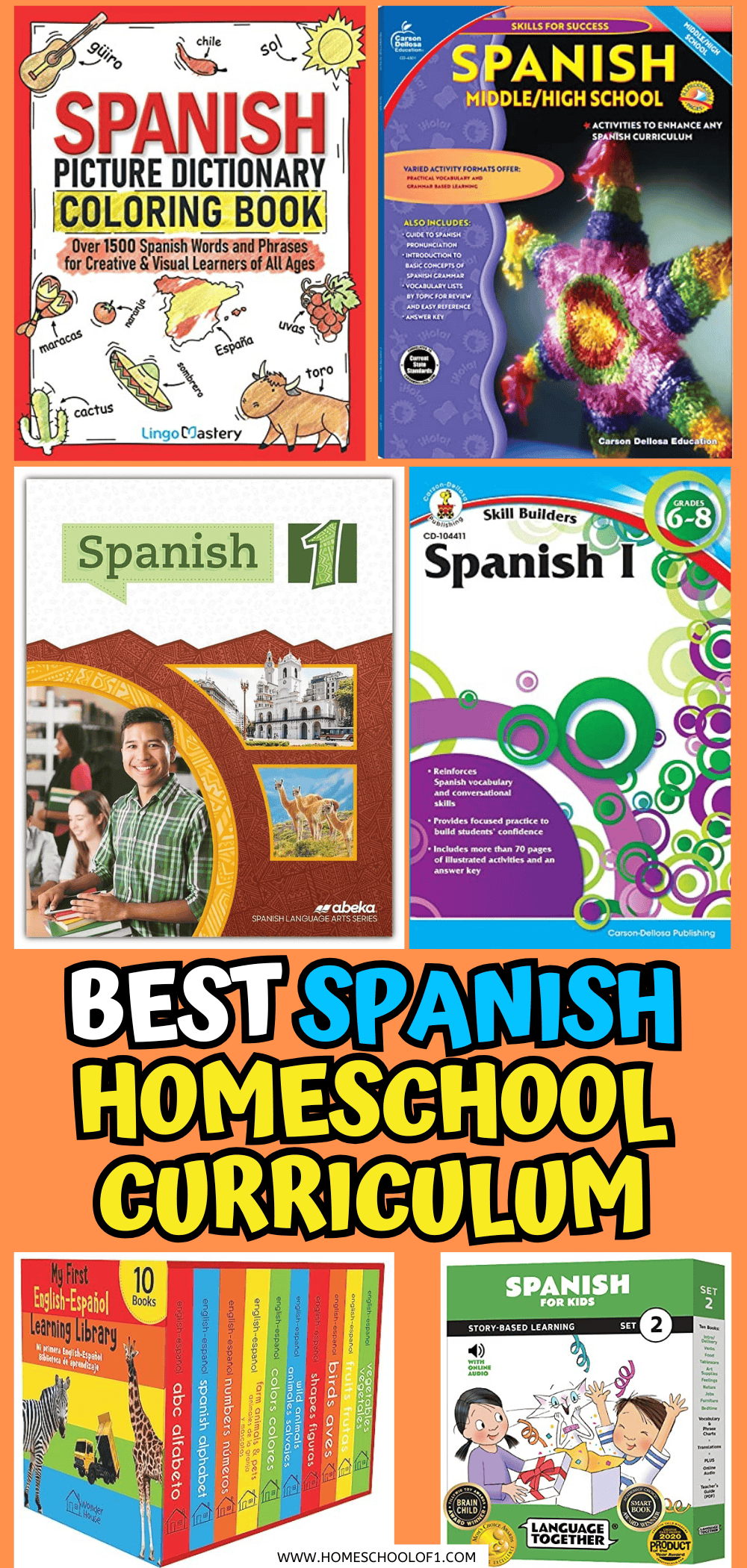
**This post may contain affiliate links. As an Amazon Associate and a participant in other affiliate programs, I earn a commission on qualifying purchases.**
Why We Chose to Learn Spanish at Home
Spanish felt like the most practical second language to focus on. It’s widely spoken, useful in everyday life, and there are tons of resources available for all ages.
For younger kids, we noticed how quickly they picked up words through songs, books, and repetition. With older students, it’s helped build confidence, especially when they can speak or understand in real conversations.
Whether your child wants to use Spanish in travel, college, or future careers, learning it at home gives you the freedom to go at your own pace while still building real language skills.
How We Picked Our Spanish Program
With so many homeschool Spanish resources out there, we narrowed it down by asking three key questions:
- Would my son stay engaged with this long-term?
- Does it teach listening and speaking, not just vocabulary?
- Can we realistically keep up with it week to week?
We tried a few different styles, some were too rigid, others too open-ended. What worked best was a mix: something structured enough to build core skills, but flexible enough that it didn’t feel like just another worksheet.
If you’re choosing a program, consider how your child responds to visual vs. verbal learning, whether they need step-by-step guidance, and how much time you realistically want to spend supporting it.
Spanish Student Workbooks
We’ve gone through a lot of Spanish textbooks over the years—some were fun but shallow, others too dry.
These are the ones that actually helped my son build vocabulary, grammar, and confidence across different stages of learning. I’ve grouped them by age to make it easier to find the right fit.
Preschool – Early Elementary
For younger learners, we looked for colorful, hands-on books with simple vocabulary and repetition. These worked well when paired with daily review and songs.
- My First English – Español Learning Library – This set of 10 board books introduces young children to both Spanish and English with simple stories and colorful illustrations, making it a fun way to encourage early bilingualism.
- Complete Book of Starter Spanish (PreK-1st Grade) – Designed for beginners, this workbook features tracing, coloring activities, and lessons on seasons and weather, making early Spanish learning more interactive.
- The Spanish Workbook for Kids (Grades K-5) – A favorite in our homeschool, this book introduces essential topics like numbers, colors, and days of the week through engaging activities that make learning feel natural and enjoyable.
- Spanish for Kids (Ages 3-8) – This collection of 10 beginner-level Spanish books includes online audio support, helping young learners build vocabulary through interactive storytelling.
- 12 Spanish Educational Posters – These bilingual posters cover key concepts like the Spanish alphabet, numbers, and common phrases. They serve as a great visual reference for young learners and help reinforce daily practice.
Elementary (Grades 1-5)
At this stage, my son needed more structure, these books offered a good balance of guidance and flexibility.
- Complete Book of Spanish (Grades 1-3) – With vocabulary lessons, songs, and flashcards, this workbook provides a structured yet interactive way to reinforce early Spanish skills.
- Skills for Success Elementary Spanish – A mix of vocabulary exercises, puzzles, and writing activities makes this a useful resource for homeschoolers looking to build foundational Spanish skills.
- Teach Them Spanish! (Grade 4+) – This curriculum focuses on structured vocabulary and grammar progression, helping students move beyond basic phrases and develop sentence-building skills.
Middle & High School
Here’s where more formal grammar and sentence-building became important. These options made Spanish feel more like a real language, not just vocabulary drills.
- Spanish 1 (Abeka) – A structured curriculum that introduces grammar rules, vocabulary, and sentence-building exercises, making it a strong choice for students seeking a traditional language program.
- Carson Dellosa Skill Builders Spanish I Workbook (Middle School) – This workbook focuses on conversational skills and commonly used phrases, making it an effective tool for middle schoolers working on language fluency.
- Getting Started with Spanish: Beginning Spanish for Homeschoolers (Any Age) – A flexible, self-paced guide that works well for older beginners, including parents learning alongside their children.
- Carson Dellosa Skills for Success: Spanish (Middle & High School) – This workbook includes grammar drills, translation exercises, and comprehension activities to support independent study.
- Spanish for Middle & High School Students (Grades 6-12) – Focused on vocabulary development and grammar reinforcement, this workbook includes audio exercises to improve pronunciation and listening comprehension.
- Spanish Picture Dictionary Coloring Book – With over 1,500 words and phrases, this coloring book caters to visual learners, reinforcing vocabulary through an engaging and creative approach.
Online Homeschool Spanish
Some of the most effective Spanish learning we’ve done at home came from online tools. They kept things interesting, especially when we needed a break from workbooks or wanted more listening and speaking practice.
Here are the ones we’ve used and liked, broken down by style.
Learn Spanish Through Games & Video
Lingopie – This was a fun surprise, basically, kids watch TV shows in Spanish with subtitles. It’s immersive without being overwhelming. Great for picking up everyday phrases and pronunciation naturally. We go into more detail in our full Lingopie review.
Duolingo – Still one of our go-to apps. It turns Spanish practice into short, game-like lessons. Works well for independent learners who want to track progress and earn streaks.
1:1 and Group Spanish Classes
Outschool – 1:1 Spanish Tutoring with a Native Speaker – Live sessions with native speakers gave my son real conversation practice, which made a huge difference in his confidence. Especially helpful when I couldn’t correct his pronunciation myself.
Outschool – Spanish Fun Club for Beginners – Perfect for younger kids—lots of games, songs, and movement. My son stayed engaged and started using Spanish words around the house.
Outschool – Spanish Immersion for Beginners – This was a nice balance between fun and structure. Taught by native speakers, it felt like a gentle push into real language use.
Outschool – Spanish Made Simple for Teens – For older kids ready to level up. Small group format means they still get attention but can practice with peers too. My teen appreciated the slower pace and practical focus.
Self-Paced Spanish Learning
Babbel – A more structured option, better for middle school and up. It covers grammar and pronunciation with interactive feedback. We liked the lifetime access—no pressure to rush through it.
What’s worked best for us has been mixing different tools. Workbooks gave us structure, apps kept things light, and live classes helped build real confidence. Whichever route you take, the key is staying consistent and finding resources your child genuinely enjoys using.
If you’ve tried any of these or found other programs that worked for your family, I’d love to hear about them—just leave a comment below.
Last Updated on 15 May 2025 by Clare Brown

